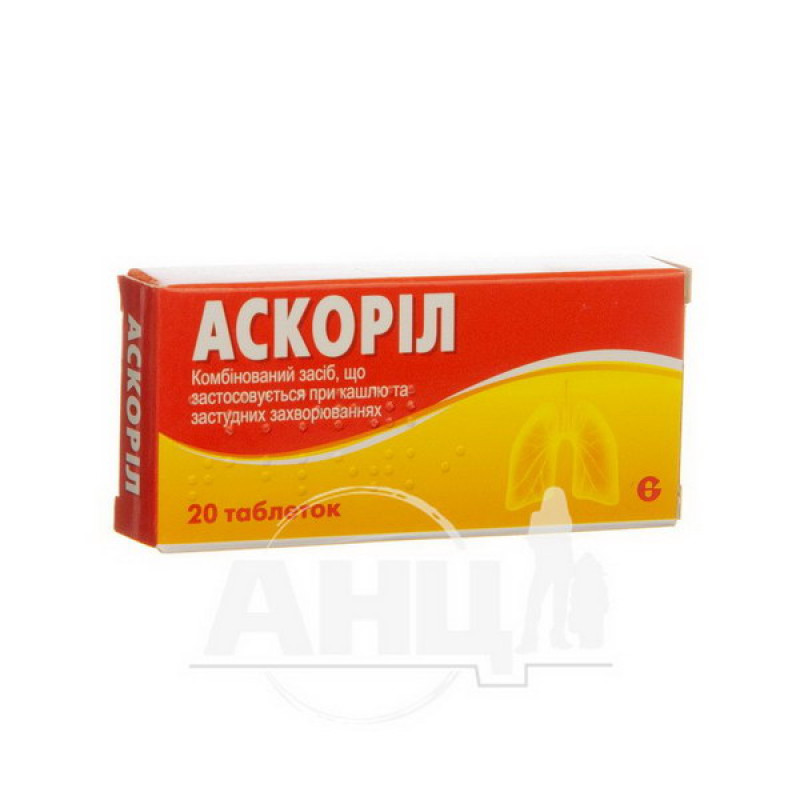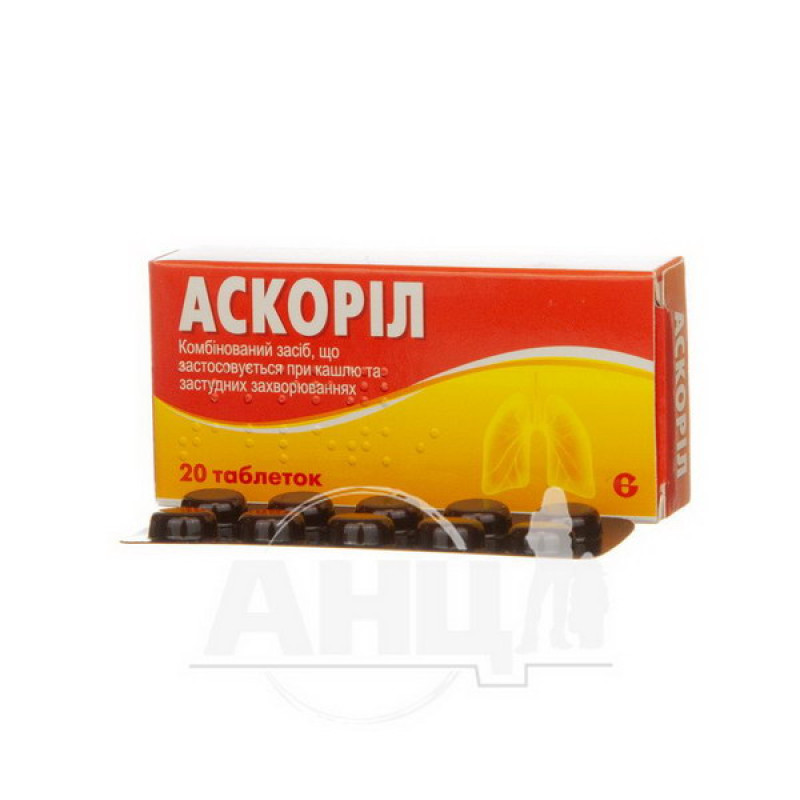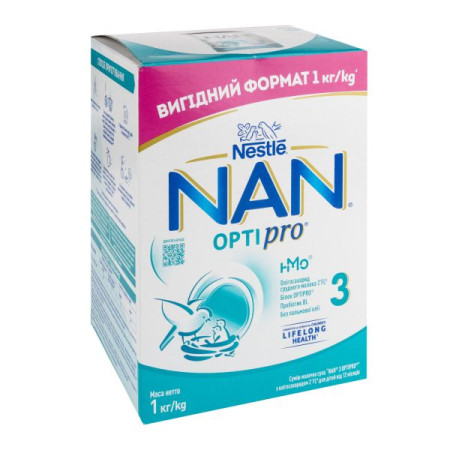Ascoril tablets No. 20

Instructions for Ascoril tablets No. 20
Composition
active ingredients: 1 tablet contains salbutamol sulfate equivalent to salbutamol 2 mg, bromhexine hydrochloride 8 mg, guaifenesin 100 mg;
excipients: calcium hydrogen phosphate, corn starch, methyl parahydroxybenzoate (E 218), propyl parahydroxybenzoate (E 216), talc, colloidal anhydrous silicon dioxide, magnesium stearate.
Dosage form
Pills.
Main physicochemical properties: white, round, flat tablets with beveled edges, with a break line on one side.
Pharmacotherapeutic group
Combined remedies used for coughs and colds. Expectorants. Combinations.
ATX code R05C A10.
Pharmacological properties
Pharmacodynamics.
Salbutamol. Salbutamol is a direct sympathomimetic, a selective agonist of β2-adrenergic receptors. The main action of β-adrenergic agonists is the ability to stimulate adenylate cyclase, an enzyme that catalyzes the formation of cyclic adenosine monophosphate (cAMP) from adenosine triphosphate (ATP). An increase in the amount of cAMP causes relaxation of bronchial smooth muscle and inhibits the release of mediators of immediate hypersensitivity from cells, especially mast cells. Salbutamol relaxes the smooth muscles of the bronchi, uterus, vascular bed of skeletal muscles. Salbutamol has a stronger and longer effect on β2-adrenergic receptors than isoproterenol. Salbutamol can also improve the mechanisms of mucociliary transport.
Bromhexine has an expectorant and mucolytic effect. Bromhexine is a derivative of benzylamine and vasicin. Increases the volume of sputum, reduces its viscosity and promotes its evacuation from the bronchi; stimulates hydrolytic depolymerization of mucoprotein fibers and stimulates the activity of the ciliated epithelium. It is known that bromhexine causes the release of lysosomal enzymes by bronchial glands.
Other pharmacological effects of bromhexine are also known: increased secretion of exocrine glands (e.g., lacrimation) and increased production of pulmonary surfactant. Simultaneous use of bromhexine with oxytetracycline, erythromycin, ampicillin, amoxicillin leads to an increase in their concentration in sputum.
It is believed that the increase in exocrine gland secretion during the use of bromhexine may be contributed by the metabolite of bromhexine, ambroxol (NA-872).
Guaifenesin. The action of guaifenesin is to stimulate receptors in the gastric mucosa and reflexively stimulate the secretion of the glands of the respiratory tract. As a result, the volume increases and the viscosity of bronchial secretion decreases.
Pharmacokinetics.
Salbutamol.
Salbutamol is well absorbed from the digestive tract, its bioavailability is from 50% to 85%. After oral administration, the maximum concentration (Cmax) in the blood plasma occurs after 1-4 hours (Tmax). Food does not affect the bioavailability of salbutamol. It binds to proteins in an amount of 10%. The volume of distribution (Vd) is 156 +/- 38 liters. Salbutamol is metabolized in the liver to an inactive sulfate conjugate. Salbutamol is excreted mainly by the kidneys. From 64% to 98% is excreted in the urine and 1.2-7% in the feces. The half-life of salbutamol is 3-6.5 hours.
Bromhexine.
Bromhexine is well absorbed from the digestive tract. The maximum concentration of bromhexine in the blood serum occurs approximately 1 hour after taking the drug. It is metabolized in the liver to the active metabolite - ambroxol. Bromhexine is excreted mainly in the urine in the form of metabolites, only a small part of it is excreted unchanged. The half-life of bromhexine is 6.5 hours.
Guaifenesin.
Guaifenesin is well absorbed from the gastrointestinal tract. 60% of guaifenesin is hydrolyzed in the blood within 7 hours to form b(2-methoxyphenoxy)-lactic acid. Guaifenesin is excreted in the urine as metabolites. The half-life of guaifenesin is 1 hour.
Indication
Symptomatic treatment of productive cough in various respiratory diseases accompanied by bronchospasm.
Contraindication
Hypersensitivity to salbutamol, other sympathomimetics, bromhexine, guaifenesin, menthol or any of the other components of the drug. Coronary insufficiency, arrhythmia, other severe cardiovascular diseases, hyperthyroidism, severe liver dysfunction, gastric and duodenal ulcers.
Special safety measures.
Salbutamol, like other β-adrenergic stimulators, should be prescribed with caution to patients with seizure disorders and diabetes mellitus.
In some patients, as with any other β-adrenergic agonist, clinically significant changes in systolic and diastolic blood pressure may occur. It is known that β-adrenergic agonists can cause ECG changes such as: T wave flattening, QT interval prolongation, ST segment depression. Therefore, salbutamol should be used with caution in patients with cardiovascular disease, especially in hypertension.
Guaifenesin should be used with caution in the treatment of cough with excessive sputum production, persistent or chronic cough resulting from smoking, asthma, chronic bronchitis, emphysema.
Interaction with other medicinal products and other types of interactions
Concomitant use of monoamine oxidase inhibitors and indirect sympathomimetics often causes hypertensive crisis. Direct sympathomimetics are not contraindicated for use in patients treated with MAO inhibitors. However, isolated cases have been described in which the occurrence of side effects such as tachycardia and hypomanic states was associated with this interaction.
In healthy volunteers who took digoxin for 10 days, an increase in its concentration from 16% to 22% in the blood serum was observed after a single administration of salbutamol.
Hypokalemia, which develops as a result of the use of drugs containing salbutamol, may increase with the simultaneous use of diuretics. As a result, the risk of developing arrhythmias increases when used against the background of such treatment with cardiac glycosides. The effects of salbutamol may be reduced with the simultaneous use of β-blockers, especially non-selective (such as propranolol), and may also be enhanced with the simultaneous use of xanthines (such as theophylline).
β-blockers can not only block the bronchodilator effect of β-agonists, but also cause bronchospasm in patients with bronchial asthma. Therefore, the use of β-blockers is contraindicated in patients with asthma.
However, in certain circumstances, such as prophylaxis after myocardial infarction, β-blockers may be considered for patients with asthma. In such cases, they should be used with caution.
Diuretics: β-agonists may worsen ECG changes and/or hypokalemia caused by potassium-sparing diuretics (such as loop and thiazide diuretics).
Although the clinical significance of these effects is unknown, caution is advised when co-administering β-agonists with potassium-sparing diuretics.
Salbutamol should not be used simultaneously with inhalation anesthetics, adrenaline, tricyclic antidepressants and corticosteroids.
It is also not recommended to use salbutamol and other oral sympathomimetics simultaneously, as such a combination may lead to cardiovascular disorders.
Bromhexine should not be administered simultaneously with drugs containing codeine. With the simultaneous use of bromhexine and drugs that irritate the digestive tract, mutual enhancement of the irritating effect on the gastric mucosa is possible. Simultaneous administration with antibiotics (amoxicillin, erythromycin, cefuroxime, doxycycline), sulfonamide drugs contributes to an increase in their concentration in bronchial secretions. When administered simultaneously with drugs that suppress the cough center, difficulty in the discharge of thinned sputum (accumulation of bronchial secretions in the respiratory tract) is possible. Simultaneous administration with bronchodilators is possible.
Guaifenesin enhances the effects of central nervous system depressants and ethanol. It may also cause false-positive results in diagnostic tests for 5-hydroxyindoleacetic acid and vanillylmandelic acid in urine.
There is no data on the negative interaction of menthol with other drugs.
Application features
The drug should be used with caution in patients with glaucoma.
Very rarely, severe skin reactions, such as Stevens-Johnson syndrome and Lyell's syndrome, occur with the use of bromhexine. If changes appear on the skin and mucous membranes, you should immediately consult a doctor and stop using the drug.
In case of impaired bronchial motility, accompanied by the formation of a large amount of bronchial secretion (malignant cilia syndrome), the drug should be used with extreme caution due to possible stagnation of secretions.
In case of impaired renal function (including severe renal failure) or liver disease (with moderate and mild hepatic failure), it should be used with extreme caution (reducing the dose or increasing the time interval between applications).
Periodic monitoring of liver function is recommended, especially with prolonged use.
Before starting treatment and during treatment of such patients, it is necessary to monitor blood glucose levels.
Isolated cases of myocardial ischemia have been reported in association with the use of salbutamol. Patients with cardiac disease (e.g. coronary artery disease) treated with salbutamol sulfate should seek medical attention if they experience chest pain or other symptoms suggestive of worsening cardiac disease. Attention should be paid to evaluating symptoms such as shortness of breath and chest pain, which may be due to both cardiac and respiratory disease.
As with other beta-adrenergic agonists, salbutamol sulphate may cause reversible metabolic changes, such as an increase in blood sugar levels. As a result, there have been isolated reports of ketoacidosis in diabetic patients. Concomitant use of corticosteroids may exacerbate this condition.
Do not administer to patients before anesthesia.
The drug should not be used in patients with hypertrophic cardiomyopathy.
If there is a history of gastric bleeding, the drug should be used under the supervision of a physician. During treatment with the drug, it is necessary to drink a sufficient amount of fluid, which increases the expectorant effect of bromhexine.
Use during pregnancy or breastfeeding
Do not apply.
Ability to influence reaction speed when driving vehicles or other mechanisms
You should refrain from driving or operating other machinery during treatment with the drug.
Method of administration and doses
Adults and children over 12 years of age should take 1 tablet orally 3 times a day.
Children aged 6 to 12 years: ½ -1 tablet 3 times a day.
The duration of treatment is determined individually.
Children
Do not prescribe the drug to children under 6 years of age.
Overdose
Symptoms: agitation, confusion, respiratory depression, rapid breathing, impaired consciousness, ataxia, diplopia, mild metabolic acidosis, arrhythmias, chest pain, hypotension up to shock, palpitations, tachycardia and severe tremor, especially in the hands. Gastrointestinal complaints, including nausea and vomiting, convulsions, extrasystole, drowsiness, headache, hyperglycemia, abdominal pain, exacerbation of gastric ulcer.
Treatment: Symptomatic therapy, electrocardiographic monitoring is indicated to monitor cardiac function.
Adverse reactions
On the part of the immune system: hypersensitivity reactions, including rash, itching, anaphylactic reactions, including anaphylactic shock, angioedema, urticaria, oropharyngeal edema, Lyell's syndrome; rarely, erythema multiforme, Stevens-Johnson syndrome, and facial edema may occur with oral administration of salbutamol in children.
On the part of the digestive tract: dyspeptic phenomena, nausea, vomiting, diarrhea, abdominal pain, exacerbation of gastric ulcer/intestinal ulcer, gastralgia, unpleasant taste in the mouth.
Nervous system: tremor, myalgia, headache, hyperactivity, dysgeusia, dizziness, anxiety, insomnia, oropharyngeal paresthesia.
Cardiovascular system: tachycardia; peripheral vasodilation; cardiac arrhythmias, including ventricular fibrillation, supraventricular tachycardia and extrasystole; hypotension or hypertension; palpitations; myocardial ischemia; collapse.
From the respiratory system: respiratory disorders, increased cough.
Salbutamol may cause paradoxical bronchospasm, which is a life-threatening condition. If this occurs, the drug should be discontinued immediately and alternative treatment should be instituted.
Other: myospasm, muscle cramps, feeling of pressure in the muscles, hyperthermia, chills, mydriasis, bladder atony, increased sweating, hyperglycemia, thrombocytopenia, metabolic changes such as hypokalemia.
Some patients may develop a transient increase in blood aminotransferase levels caused by bromhexine.
Methyl parahydroxybenzoate (E 218) may cause allergic reactions (possibly delayed).
Expiration date
2 years.
Storage conditions
Store in a dry place, protected from light, at a temperature not exceeding 25 °C.
Keep out of reach of children.
Packaging
10 tablets in a blister, 1 or 2 or 5 blisters in a cardboard box.
Vacation category
According to the recipe.
Producer
Glenmark Pharmaceuticals Ltd./Glenmark Pharmaceuticals Ltd.
Location of the manufacturer and its business address
1. Plot No. E– 37/39, MIDC Industrial Estate, Satpur, Nasik - 422 007, Maharashtra, India.
2. Village - Kishanpura, Baddi-Nalagarh Road, Tehsil Nalagarh, Disst. Solan, HP 174101, India.
There are no reviews for this product.
There are no reviews for this product, be the first to leave your review.
No questions about this product, be the first and ask your question.







